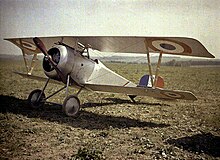Nieuport (company)
Nieuport was a French manufacturer of aircraft .
history
The company was founded by the brothers Édouard (1875-1911) and Charles de Nieuport (1878-1913) (some sources only name Édouard as the company's founder) in 1902 under the name Nieuport-Duplex as a supplier for aircraft engine production. The production facilities were in Issy-les-Moulineaux . The first attempt in aircraft construction was a machine with a Darracq auto engine (28 hp) in 1908 , which is said to have been just over 70 km / h.
In 1909 the company was restructured (ignition systems for aircraft engines were also manufactured) and renamed Société Générale d'Aéro-locomotion . Towards the end of 1909, the draft of a modern model with a closed cockpit was completed, again a monoplane, powered by a 50 hp Gnome engine. In 1911 it was decided to start series production of aircraft in addition to the existing product range. The name was changed again to Nieuport et Deplante .
In the same year, a Nieuport model achieved the new speed record for aircraft of 133.14 km / h.
Another Nieuport in-house design was known as the Nieuport Type 2-N, a single-seat monoplane with a 22 kW engine; this machine reached about 110 km / h. Also in 1911, the French armed forces held a competition to identify suitable aircraft for the first time. Originally 110 machines took part in this comparison; In addition to samples from Bleriot and Deperdussin , the model from Nieuport was one of the three winners.
After the death of Édouard de Nieuport in 1911, Henry Deutsch de la Meurthe took over the company, and it was renamed Société Anonyme des Établissements Nieuport . The designs available in the company were further developed. After Charles de Nieuport was also killed in an air accident in 1912, the company fell behind the competition, something the newly hired chief designer, the German Franz Schneider, was unable to change. When the Russian pilot Pyotr Nikolajewitsch Nesterow managed to fly a loop with a Nieuport IV monoplane in 1913, the Russian air force acquired a few copies of this type. However, the model, like the Nieuport Type 6 M, which was in service with the aviation troops of France, Russia and Italy at the outbreak of World War I , was already out of date at that time.
With the arrival of Gustave Delage as chief designer in 1914, fundamental changes were made, and Nieuport managed to make up for the lag behind the competition. Delage began developing a biplane racing aircraft (actually a one and a half decker). However, with the outbreak of war there was no need for racing planes. However, the basic concept of the machine seemed suitable to the military, and so the British Royal Flying Corps acquired several copies of this model, now known as the Nieuport 10 . Later this machine was also acquired by France and Russia. The Nieuport company and its chief designer Delage became one of the most famous manufacturers of French military aircraft from the First World War. The most successful designs are the Nieuport 11 and Nieuport 17 .
The company later merged with Astra, a balloon manufacturer, to form Nieuport-Astra, but changed the name to Nieuport-Delage a short time later . At that time, Nieuport no longer produced any successful aircraft models, and an attempt to successfully participate in the Schneider Trophy in 1932 also failed. After Gustave Delage had finished his work in 1932 (other sources: 1934), the company was renamed Nieuport , which shortly afterwards became the SNCAO (Société Nationale de Construction du Sud Ouest) during the restructuring of the French aircraft industry . One of the last aircraft that bore the name Nieuport was the flying wing Nieuport SGA-914T from 1932. At the Paris Aero Salon in 1932, the Nieuport-Delage company presented the touring aircraft. The machine was equipped with a 110 HP Lorraine radial engine with a pressure screw and had a new type of wing structure made of welded steel tubes. Although the SGA-914T was one of the few flying wings of the time with good flight characteristics, it was not possible to find buyers for it.
literature
- Günter Schmitt, Werner Schwipps: Pioneers of early aviation . Gondrom, Bindlach 1995, ISBN 3-8112-1189-7 .
Web links
- Nieuport aircraft types (dt) [1]
- Company and Nieuport types (fr) [2]
- Nieuport types [3]
- Image from Nieuport airfield [4]
Individual evidence
- ↑ EDOUARD NIEUPORT (rue) ( memento of January 1, 2008 in the Internet Archive ) on the municipality of Issy-les-Moulineaux

